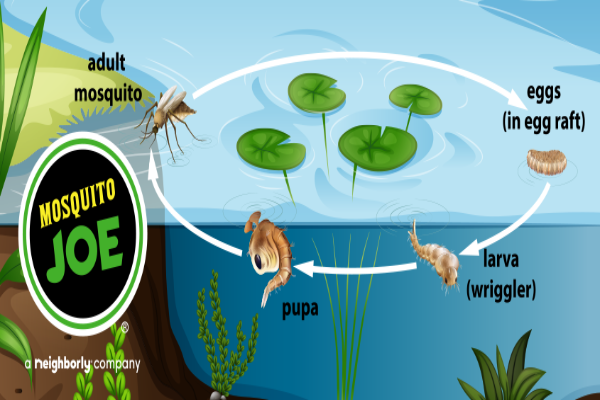
Mosquito Joe explains the mosquito life cycle, highlighting key developmental stages.
|
Ouch! Did you just get bitten by a mosquito? There’s nothing worse than an unwelcome party guest, especially when you just want to enjoy the warmer months without the presence of these bussing pests. Part of proper mosquito control is understanding the mosquito life cycle and learning when to disrupt it.
What is the Life Cycle of a Mosquito?
Did you know that adult female mosquitoes can lay eggs individually or by the hundred all at once? Sometimes, these eggs hatch within 48 hours, but other times, they endure freezing temperatures and dry conditions for long periods before eventually hatching.
The mosquito's life cycle has four separate phases: egg, larvae, pupa, and adult. Each of these stages can be easily recognized by its special appearance and preferred habitat. Understanding where to find each stage will help you develop a mosquito control plan.
Egg Stage
The mosquito life cycle starts with the egg phase, where female mosquitoes lay hundreds of eggs directly on or near standing water. Some mosquito species, like the Culex species, will lay eggs attached to each other to form “rafts.” Meanwhile, other species, such as Aedes mosquitoes, lay only single eggs.
Although they only need moist or damp environments to lay their eggs, water is required for them to hatch, regardless of the species. This will typically happen within 48 hours. Once this happens, the mosquito moves into the next stage of development.
Larvae and Pupa Stages
After hatching, mosquitoes begin the larvae stage. They are often referred to as “rollers” or “wigglers” because of how they appear while swimming.
Larvae live in the water and come to the surface to breathe, molting their skin four times and growing larger with each molt. Most larvae have tubes for breathing and hang upside down from the water surface. After undergoing four stages of molting, the larvae become pupae.
The pupae stage is the mosquitoes' non-feeding stage. Pupa still live in the water and continue to swim around. Since they are lighter than water, they live at the surface and must occasionally take oxygen through breathing tubes called “trumpets.” During this stage, the adult mosquito begins to develop, which can take up to four days, depending upon the temperature of the water. They are often referred to as “tumblers” because when disturbed, pupae tumble down to the safety of deeper water and gradually float back to the surface, hoping any threats will be gone.
This stage is when the population is hardest to control, as they are resting and relatively inactive before making their grand entrance as adult mosquitoes.
Adult Mosquito Stage
The fourth and final stage of the life cycle of mosquitoes is the adult stage. During this phase, adult mosquitoes will rest on the water with two concerns: mating and feeding.
Once the body is completely dry and hardened and the wings have fully opened, they can start to fly. Males locate females by the sound of their wings. Once they mate, the life expectancy of a mosquito varies. Males will live three to five days, and females will live considerably longer, upwards of one to two months.
That short life expectancy is still enough time to wreak havoc in their environments, especially among humans. During this relatively short adult phase, mosquitoes can spread diseases like Malaria, Dengue, Yellow Fever, West Nile Virus, Zika, Chikungunya, and more. Spread through their bites, mosquitoes can transfer these diseases into their host through their saliva.
How to Break Up the Mosquito Life Cycle
Disrupting the mosquitoes' life cycle is important for reclaiming your outdoor space. While you can get rid of mosquitoes at any point of their lifecycle, targeting the egg or larvae stage is often the more effective approach. Some ideas to disrupt the mosquito life cycle include:
- Removing standing water, both natural and man-made, from your yard.
- Keeping your lawn cut short.
- Regularly trimming and maintaining shrubs, trees, and other plants.
- Exploring professional pest control services.
- Setting up mosquito traps and other maintenance solutions.
Mosquito Control Services During Any Stage
If taking your yard back from a mosquito invasion feels stressful, don’t worry! Your locally owned and operated Mosquito Joe® knows exactly how to disrupt the life cycle and evict those pesky biters!
Our service professionals are trained mosquito control experts dedicated to one thing: getting rid of mosquitoes so you can enjoy being outside again. Rest assured, knowing that our experts are hard at work, supplying services backed by the Neighborly Done Right Promise® and the Mosquito Joe Satisfaction Guarantee.
Show those mosquitoes who’s boss. Request a free quote from Mosquito Joe today!
This article is intended for general guidance only and may not be applicable to every situation. You are responsible for determining the proper course of action for your property and your situation. Mosquito Joe is not responsible for any damages that occur as a result of any advice or guidance derived from blog content. For the most accurate guidance, contact an independently owned and operated Mosquito Joe for more information and a professional on-site assessment.
